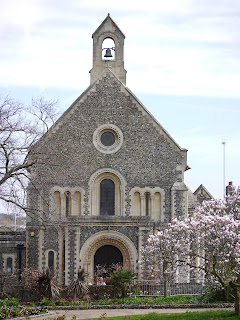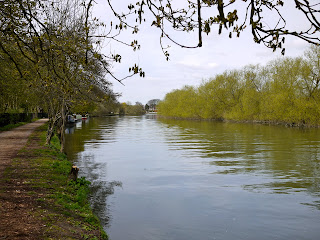We had our friends from Bristol to visit and we thought we would reciprocate the city walk they took us on in Bristol with a town walk around Reading (a would-be city). We started at the station car park, walked out the front, admiring the Italianate original station buildings and along Station Road, paying attention to the ornate upper storeys of the shops. Then along Friar Street to the former Town Hall, a handsome red brick building of 1872-5 by Alfred Waterhouse.
Nearby is Reading's oldest church, St Laurence, which is currently being restored. Once it had one of the gates to Reading Abbey next to it. We come to the Abbey ruins later on the walk and it was striking just how far away they were - or, just how large the Abbey complex was.
We walked past The Library and Art Gallery next door to the Town Hall, less imposing, but harmonises well with it. Then we turned into Valpy St to discover a building I was quite unaware of until I planned this walk: the abbey hospitium, now a day nursery, tucked away among modern office blocks. It dates from 1486 and on this side there is an interesting brick stair turret.
The hospitium, which provided accommodation for pilgrims and visitors, is more clearly visible from the other side, St Laurence's churchyard.

We crossed the road to enter Forbury Gardens, once the outer court of the abbey. The first and most striking sight is the massive statue of a lion, the Maiwand Lion, erected in 1886 to commemorate the deaths if 329 men of the Royal Berkshire Regiment at the battle of Maiwand in Aghanistan in 1880.
On the south side is the inner Abbey gateway, 13th century, but much restored by Scott in 1869 - and now partly covered by scaffold and boarding for fear of falling masonry. A shame as it is a handsome sight. On the same side is the former Shire Hall of 1904-11, a little gem of a building, now a hotel.
To the east is St James RC church. It was built 1837-40 by AWN Pugin. It is one of his first churches and the only one in the Norman style. We did not quite get there in time to have a look at the interior.

In the same direction, to the right, can be seen the abbey ruins and beyond them the central tower of Reading Gaol of Oscar Wilde fame. The abbey ruins - just the core of some walls, no finished stonework - are closed for the foreseeable future because they too have become dangerous.

We walked along Forbury Road, past the church and the modern security walls of the prison and reached the bridge over the Kennet. Here we backtracked under the prison walls to the other entrance to the ruins. This area has recently been made into the Oscar Wilde garden. A nice idea, but without much impact.
Then along King's Road past the remaining building of Huntley and Palmer's biscuit factory, which contributed much to the prosperity of Reading (and indeed of the Palmer family) in the 19th century. Most of the site now houses a Prudential office block.

We now walked along the Kennet tow path, with a housing development on one side and sundry industrial remains on the other. This redundant gas holder seemed to fill the sky.

Soon we reached the fine Brunel-built bridge which marks the point where the Kennet flows into the Thames. We saw the black swans we first noted on the Reading to Ashenbury Park leg of the Berkshire Way 18 months ago - at least I imagine they are the same ones, it was certainly nearby.

The river was calm and inviting.

Then we came to Reading bridge which effectively marked the end of the walk.

From: 50 walks in Berkshire and Buckinghamshire (AA) - with some modifications.
Map: Explorer 159 (Reading, Wokingham and Pangbourne).
Conditions: dry, sunny, reasonably warm.
Distance: a bit under 4 miles.
Rating: three and a half stars.
Reflections
I have lived in this area for most of my adult life, but this route revealed a wonderful old building I have never noticed and took me along the Kennet tow path in a direction I have never previously walked in. I have also been in the Forbury gardens a fair few times and never really stopped to study the panorama of buildings to be seen from it. Nor did I realise that the little hill it contains was built during the Civil War as a gun emplacement.
This just reinforces the need to behave as though you are seeing somewhere for the first time to get the best out of a town walk. Something of the same is true for any walk, but in a town you are much more likely to take the area you are walking through for granted. You also need to look up more in a town.

No comments:
Post a Comment